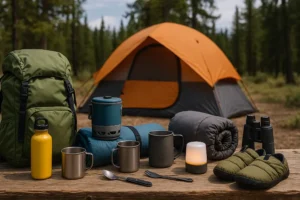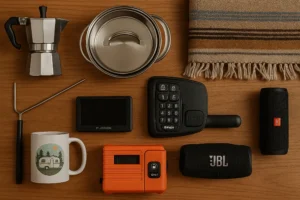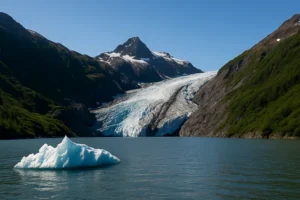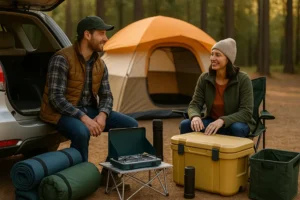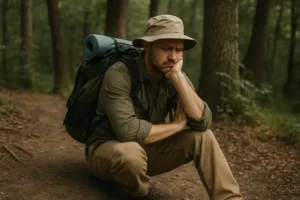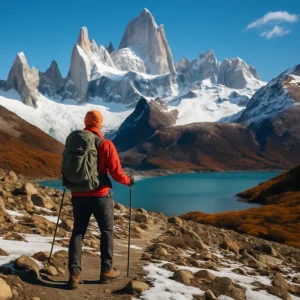The Teton Crest Trail is not just a hike, it’s a high-altitude, high-mileage, high-reward odyssey. Spanning roughly 38 to 40 miles through the heart of Grand Teton country, it offers every kind of emotion in a single day: awe, exhaustion, elation, and maybe even a little regret. I set out on this trail knowing it would be hard. I didn’t know just how much it would take, and give, until the very last step. This wasn’t a stroll through the woods. It was a full-on traverse with nearly 10,000 feet of elevation gain and a race against daylight.
Let me take you through what it’s really like to tackle this monster in a single push, and what you need to know before trying it yourself.
The Plan: Go Big or Go Home
The trailhead sits at the Granite Canyon parking lot, quiet and cool on a crisp fall morning. We were trying to beat an incoming storm, squeeze in one last colorful day before the snow, and, if I’m honest, escape the chaos of life for a few hours (or ten).
The goal? Hike from Granite Canyon Campground, climb to the high alpine shelf, drop into Alaska Basin, traverse Cascade Canyon, make the painful push to Paintbrush Divide, then exit at String Lake, where our bikes waited for us. Yes, bikes. Because what’s a 38-mile hike without a 16-mile bike ride to finish?
Insane? Maybe. But sometimes, that’s the point.
Granite Canyon to the Shelf: A Trail Tease
The first few miles into Granite Canyon are a dream. Cool air, golden leaves, and early morning sunlight creeping over the peaks. It’s the kind of beginning that tricks you into thinking the day will be breezy. But don’t be fooled.
About eight miles in, reality starts to sink in. The legs feel it. The elevation starts to play games. At this point, we were staring at 30 more miles to go, and we hadn’t even hit the hard stuff yet.
But once we reached the alpine shelf, the reward was immediate. The Grand Teton loomed in the distance, and the views started punching harder than the lactic acid in our quads. Starting in Granite Canyon is a power move. You get the scenery early, which helps carry you through the pain.
Alaska Basin: High Country, Low Fuel
We made our way off the shelf and into Alaska Basin. Around mile 16, we had racked up roughly 4,700 feet of climbing. The trail was kind, the views unrelenting, and the weather? Absolutely perfect.
But then reality hit. I had completely forgotten proper trail food. No gels. No real nutrition. Just a haphazard selection of gas station snacks crammed into my pack. Rookie move. The irony? I’d made fun of someone for puking during a past glacier run. Karma doesn’t wait long.
Hurricane Pass: Where Beauty Hurts
Hurricane Pass marked mile 20. It’s the crown jewel of the day, with unobstructed views of the Grand, Middle, and South Tetons. You stand there, panting, blistered, and aching, yet totally overwhelmed by what’s in front of you.
But the moment is short. The clock is ticking. The trail ahead dips and climbs again, and it’s time to move.
We faced a long descent, which should’ve been easy. But with this kind of mileage, nothing feels easy. It was just the calm before the storm, literally and physically. Paintbrush Divide was coming. And with it, the decision that could break the day.
The Decision: Quit or Climb?
Just before the climb to Paintbrush, one in our group faltered. Legs were heavy. Brain was foggy. A strong argument was made for bailing out down Cascade Canyon.
I can’t blame them.
There’s a moment in every brutal effort where quitting makes perfect sense. This was that moment. A 3,000-foot climb loomed, and the clock said we might not beat the dark. The mental gymnastics began.
Eventually, a choice was made: keep going. Slowly. Painfully. Together.
Was it dramatic? Yes. Was it worth it? You bet.
The Climb to Paintbrush Divide: Pure Grit
Mile 27. Around 7,000 feet of gain so far. Legs throbbing. Altitude pressing. The trail from Lake Solitude to Paintbrush Divide is a test of character as much as fitness.
Somehow, things clicked. A bite of a quinoa-sweet potato burrito, a few swigs of water, some ibuprofen, and a hit of caffeine. Suddenly, the body remembered how to function. The climb was steep and unrelenting, but the views kept paying out like slot machines. Solitude Lake behind us, endless alpine ahead.
With the last few steps to the divide, nausea peaked. But the view? It cured more than any medicine could. The hardest climb was done. Gravity would take care of the rest.
The Final Descent: Stumbling Toward Success
Coming down from Paintbrush Divide wasn’t fast. It wasn’t elegant. It was survival.
Feet dragging, muscles shredded, we ran, jogged, limped, and hobbled our way toward String Lake. Every corner promised a view. Every switchback felt like the last one. It wasn’t.
But we made it. After nearly 11 hours on trail, we arrived at the lake. Smiles cracked through salt-stained faces. But the day? Not over yet.
Bonus Round: The Bike Ride from Hell
Remember those bikes? Yeah. We still had to ride 16 miles back to the car.
Each of us had a different setup. A road bike. A mountain bike. A city cruiser with the geometry of a lounge chair. It didn’t matter. The road was dusty, rutted, and, in the dark, brutal.
The last stretch, riding on skinny tires down a gravel road, might’ve been the hardest part of the entire day. One wrong move and it’s a broken collarbone or worse. But headlights bobbed through the dark, and we eventually rolled into the parking lot.
No moose encounters. No accidents. Just the finish line.
Final Stats:
- Trail Miles: 38 (or 40 depending on your GPS and pain tolerance)
- Elevation Gain: ~9,000 feet
- Bike Miles: 16
- Total Time: 10 hours, 50 minutes
- Calories Burned: All of them.
What You Need to Know Before Taking on the Teton Crest Trail
If you’re considering hiking (or running) the Teton Crest Trail in a single day, here’s what you absolutely must know:
1. Start Early, Really Early
Time is not your friend on this route. Start at first light or before. You’ll want every bit of daylight, especially in the fall.
2. Train Properly
This isn’t a hike you “wing.” Have endurance. Be comfortable with elevation gain. And for the love of your legs, train with weight if you’re carrying gear.
3. Fuel Like an Athlete
Don’t make the gas station snack mistake. Pack real trail food, salty, carby, calorie-dense. Your body will thank you, especially on Paintbrush.
4. Weather Moves Fast
Storms can roll in with little warning. We got lucky, but always have layers, waterproof gear, and a backup plan.
5. Consider the Exit Strategy
Whether it’s stashing bikes like we did, or arranging a pickup, the final 16 miles of road can be rough. Plan accordingly.
6. Listen to Your Body
There’s a big difference between “tired” and “too far.” Know your limits. But also remember, sometimes your limits lie to you.
Wrapping It Up
The Teton Crest Trail is pure mountain magic. It tests you. It rewards you and also i t leaves you sore, hungry, humbled, and craving more.
Would I do it again? Honestly, probably. But maybe next time I’ll pack some real food and rethink the bike.
Until then, that trail, those peaks, and that long, dusty road back to the car will live rent-free in my head.
Every aching step of it.
FAQs
The trail covers approximately 38 to 40 miles, depending on the exact route taken. Some variations may add or subtract mileage, especially with entry and exit points like Granite Canyon and String Lake.
You’ll face around 9,000 to 10,000 feet of elevation gain throughout the hike. Expect multiple steep climbs, with the final ascent to Paintbrush Divide being the most grueling.
Yes—but it’s extremely challenging. This group completed it in just under 11 hours, but only with strong endurance, pacing strategy, and a high level of fitness.
The alpine shelf, Hurricane Pass, and Paintbrush Divide offer the most breathtaking views. Expect close-up visuals of the Grand, Middle, and South Tetons along the way.
No—there are no food stations or water points provided. Carry all your nutrition and purify natural water sources as needed.
Granite Canyon is an ideal starting point. It gives you early scenic rewards and positions you for a full traverse toward Paintbrush Canyon and String Lake.
Yes. In this case, the hikers stashed bikes at the endpoint and rode 16 miles back to the starting parking lot. Other options include arranging a shuttle or car drop-off in advance.





